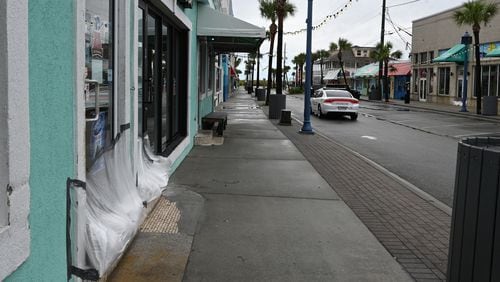Business and tourism officials in coastal Georgia breathed a sigh of relief this weekend as they were mostly spared from the worst of Hurricane Ian, after the storm made a second U.S. landfall in South Carolina on Friday.
There were reports of some isolated flooding, and some parts of the Georgia coast briefly lost power as Ian churned offshore. But Georgia escaped the devastation Ian brought to Southwest Florida.
Hotels and short-term rentals did see cancellations throughout last week, said Joseph Marinelli, president of Visit Savannah, which promotes tourism for Savannah and Tybee Island. But they also saw some last-minute bookings by hurricane evacuees.
Tybee, a low-lying Georgia barrier island, is vulnerable to flooding.
But as the day’s high tide began to recede just after noon, Alan Robertson, the resilience project manager for the city, said Tybee had escaped largely unscathed.
Robertson said some beaches saw minor erosion, but that water did not reach the sand dunes and no flooding was observed. He called the erosion typical of what the island sees after a strong Nor’easter in winter, but nothing compared to the damage Hurricane Irma caused to Tybee’s beaches and several homes in 2017.
”We really lucked out on this one,” he said.
On Friday, Marinelli said Savannah and Tybee were back open for business.
Most flights at Savannah/Hilton Head International Airport were canceled on Friday, with nearly 90 cancellations including arrivals and departures, according to FlightAware.com. The Savannah airport said it would remain open and is advising travelers to check their flight status before going to the airport.
A smaller number of Savannah flights have been canceled for Saturday, according to FlightAware data. Though some flights were canceled Saturday, Savannah airport marketing director Lori Lynah said flights should be operating on a full schedule by that afternoon. She said some of the airport’s restaurants and shops may not reopen with their full regular schedules Saturday.
In South Carolina, the smaller Hilton Head Island Airport was closed until Saturday at 10 a.m., with all flights canceled on Friday.
Hilton Head Island-Bluffton Chamber of Commerce spokesman Charlie Clark said Friday the town staff reported minimal impact on the island.
Farther south along the Georgia coast in St. Marys, which saw the storm pass through Thursday, there was some flooding. But at the town’s Riverview Hotel, “it wasn’t significant,” said Arnette West, who works at the front desk. “No damage whatsoever.”
In Florida, Tampa’s airport resumed operations at 10 a.m. Friday and the Orlando International Airport was resuming flights after noon Friday. The Fort Myers airport remained closed as of Friday morning, as airport officials assessed damage from the hurricane. All flights at the Fort Myers airport were canceled until power is restored, the airport said.
Hundreds of flights were also canceled at airports in Charlotte, North Carolina and Charleston, South Carolina on Friday, along with the ongoing flight cancellations in Florida. As a result, some flights were also cancelled at Hartsfield-Jackson International Airport, a major hub for the Southeast. About 160 flights at the Atlanta airport were canceled Friday, including about 6% of departures, according to FlightAware data.
Earlier this week, South Georgia’s farmers, many still stung by Hurricane Michael a few years ago, feared for their crops, but by Friday afternoon it appeared harvests were also largely spared.
With dry conditions expanding in the state in recent weeks, some farmers were disappointed they didn’t receive any rain from the storm, said Pam Knox, an agricultural climatologist at the University of Georgia. With little rain in the forecast, it could be some time before farmers get any relief, she said.
The storm caused some disruption for the fishing industry off Georgia’s coast, halting shellfish harvests.
“Usually when you have a hard northeast wind like we’ve had the last few days the shrimp will get pulled way offshore…up to 10 miles,” said Wynn Gale, a shrimper from Darien.
The day before the hurricane hit Ft. Myers, Florida, Gale caught 75 pounds of shrimp in a spot where he’d previously caught 600.
“Evidently the shrimp seemed to sense something was coming,” Gale said. “The barometric pressure changed and the wind direction changed and the shrimp quit.”
The Georgia Department of Natural Resources said it planned to start the process to reopen shellfish harvests on Monday.
Harvests were closed Wednesday as a safety precaution primarily for clams, which can be contaminated by bacteria carried in storm surges said Tyler Jones, with the DNR’s coastal resources division. If the coast receives more than three feet of tidal surge or three inches of rain, DNR will conduct a water quality test.
”If we calculate it, and it’s less than that, we can make a judgment call after we coordinate with the FDA,” Jones said. “We’re looking at starting the process to reopen on Monday, but that doesn’t mean we will be ready to reopen Monday.”









